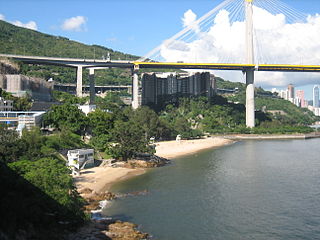
Tsing Yi, sometimes referred to as Tsing Yi Island, is an island in the urban area of Hong Kong, to the northwest of Hong Kong Island and south of Tsuen Wan. With an area of 10.69 km2 (4.13 sq mi), the island has extended drastically by reclamation along almost all its natural shore and the annexation of Nga Ying Chau (牙鷹洲) and Chau Tsai. Three major bays or harbours, Tsing Yi Lagoon, Mun Tsai Tong and Tsing Yi Bay (青衣灣) in the northeast, have been completely reclaimed for new towns.

The Tsuen Wan line is one of the ten lines of the metro network in Hong Kong's MTR. It is indicated in red on the MTR map.

Stonecutters Island or Ngong Shuen Chau is a former island in Victoria Harbour, Hong Kong. Following land reclamation, it is now attached to the Kowloon Peninsula.

Rambler Channel is a body of water in Hong Kong that separates Tsing Yi Island from Tsuen Wan and Kwai Chung in the New Territories. The channel separates the two landmasses by 900 metres at its widest point.

The Port of Hong Kong located by the South China Sea, is a deepwater seaport dominated by trade in containerised manufactured products, and to a lesser extent raw materials and passengers. A key factor in the economic development of Hong Kong, the natural shelter and deep waters of Victoria Harbour provide ideal conditions for berthing and the handling of all types of vessels. It is one of the busiest ports in the world, in the three categories of shipping movements, cargo handled and passengers carried. This makes Hong Kong a Large-Port Metropolis.
This article is a list of transport means that cross Victoria Harbour in Hong Kong.

Stonecutters Bridge is a high level cable-stayed bridge spanning the Rambler Channel in Hong Kong, connecting Nam Wan Kok, Tsing Yi to Stonecutters Island. The bridge deck was completed on 7 April 2009, and opened to traffic on 20 December that year. The bridge was the second-longest cable-stayed span in the world at the time of its completion.

The Airport Core Programme was a series of infrastructure projects centred on the new Hong Kong International Airport during the early 1990s. The programme was part of the Port and Airport Development Strategy, commonly known as the Rose Garden Project.

Sham Shui Po District is one of 18 districts of Hong Kong. It is the second poorest district in Hong Kong, with a predominantly working-class population of 405,869 in 2016 and the lowest median household income of all districts. Sham Shui Po has long been home to poorer new immigrants from mainland China. It also saw the birth of public housing in Hong Kong, as the government sought to resettle those displaced by a devastating fire in its slums. Sham Shui Po also hosted a Vietnamese refugee camp during the influx of migration in the aftermath of the Vietnam War.

Kwai Chung Road is a throughway in Kwai Chung of the New Territories in Hong Kong. It is one of the busiest roads in Hong Kong. The Transport Department has classified it as a trunk road.

Route 5 is a strategic route in Hong Kong from eastern to western Kowloon and New Kowloon, and ends in Tsuen Wan in the New Territories where it connects to Route 9. It is one of the most seriously congested routes in Kowloon, as it serves as an interchange to the Hung Hom Cross-Harbour Tunnel, especially during peak hours.

The Hong Kong Strategic Route and Exit Number System is a system adopted by the Transport Department of the Hong Kong Government to organise the major roads in the territory into routes 1 to 10 for the convenience of drivers. When the system was implemented in 2004, the government promoted it with a major public campaign, including the slogan "Remember the Numbers; Make Driving Easier".
Jardine Engineering Corporation (JEC) is a private limited company and wholly owned subsidiary of the Jardine Pacific, a member of Jardine Matheson Holdings Limited. Originally established in Shanghai in 1923 to support the group's engineering operations in China. Previously, this had been done by the group's engineering department.

Cheung Shan Estate is a public housing estate located between Shek Wai Kok Estate and Lei Muk Shue Estate, and near Shing Mun Valley Park and Shing Mun Tunnels in Tsuen Wan, New Territories, Hong Kong. Formerly the site of Cheung Pei Shan Temporary Housing Area, it consists of three residential buildings completed in 1978.

Lido Beach is located on Castle Peak Road in Ting Kau, New Territories, Hong Kong. It is a gazetted beach, meaning it is managed by the Leisure and Cultural Services Department, which provides lifeguards during the summer months.

Hoi Mei Wan Beach is a gazetted beach located near Airport Core Programme Exhibition Centre on Castle Peak Road in Ting Kau, New Territories, Hong Kong. The beach has barbecue pits and is managed by the Leisure and Cultural Services Department of the Hong Kong Government. The beach is rated as Grade 2 by the Environmental Protection Department for its water quality. The beach offers views of the Ting Kau Bridge as well as Tsing Ma Bridge.

Approach Beach is a gazetted beach located near Yau Kom Tau on Castle Peak Road in Ting Kau, New Territories, Hong Kong. The beach has barbecue pits and is managed by the Leisure and Cultural Services Department of the Hong Kong Government. The beach is rated as Grade 2 by the Environmental Protection Department for its water quality.


















